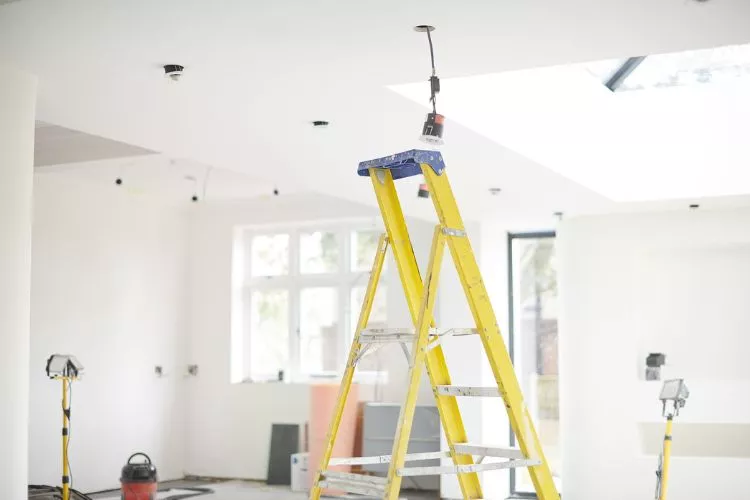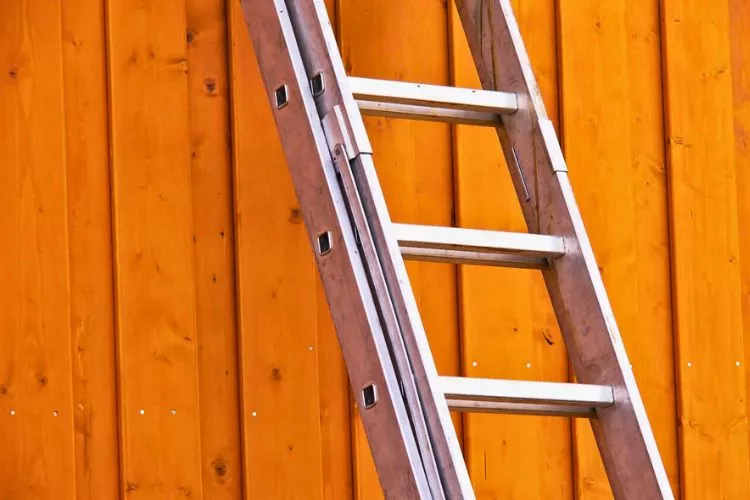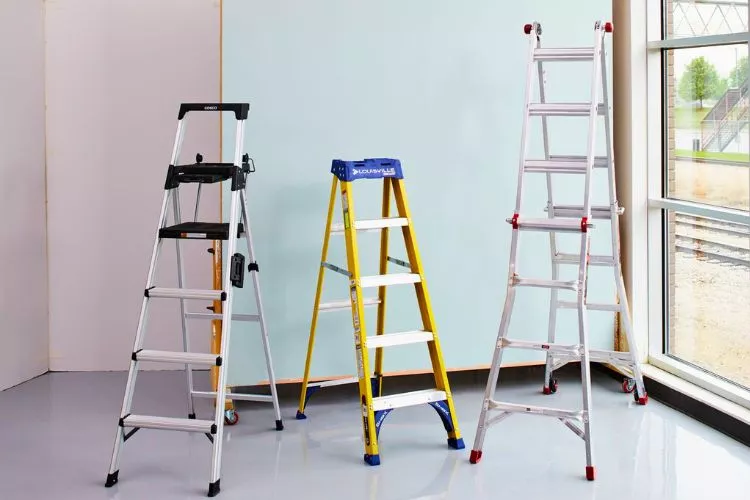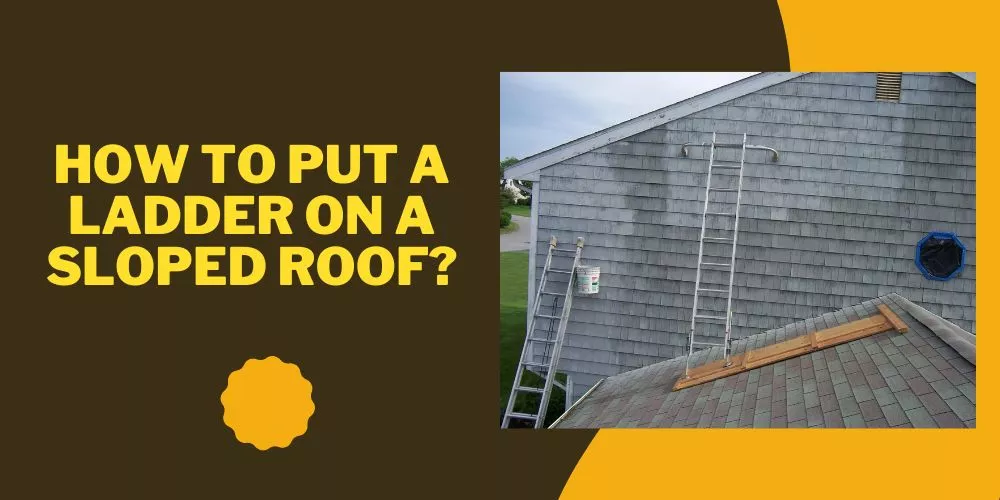We’ve all been there—climbing up a ladder to clean gutters, change a light bulb, or complete a DIY project, only to feel the unsettling wobble or notice visible damage on the ladder’s surface.
A sturdy and safe ladder is crucial for carrying out numerous tasks at home and on the job.
This article aims to provide readers with a detailed, step-by-step guide on how to repair fiberglass ladder effectively and restore its functionality, without compromising safety.

Quick Recommendations
How to repair fiberglass ladder? (A Step By step Guide)
Learning how to repair fiberglass ladder may seem intimidating at first glance, but the process is relatively simple with the right tools and proper guidance.
This article will break down each repair process step, enabling readers to confidently fix their ladder.
🪜 How to fix a weathered fiberglass ladder?

- Safety First: Before starting any work on your ladder, it’s essential to take safety precautions. Wear safety glasses, gloves, and a dust mask to protect yourself from fiberglass dust and harmful shavings if inhaled or come into contact with your skin or eyes.
- Inspection: Look closely at your ladder to identify all weathered areas. Signs of weathering on a fiberglass ladder include fading, discoloration, cracks or fractures, and flaking.
- Cleaning: Before you start with repairs, you should clean the ladder thoroughly. Use warm soapy water and a soft brush to remove grime or residue from the ladder. Remember to dry the ladder thoroughly before proceeding to the next step.
- Sanding: Next, lightly sand the weathered areas using sandpaper with a grit of 100 or lower to remove the top layer of the weathered fiberglass. Switch to a 220 grit sandpaper to smooth the area and flush it with the surrounding surface. Avoid sanding too deeply, which may weaken the fiberglass structure.
- Applying Fiberglass Resin: Prepare a fiberglass repair kit consisting of resin and hardener. Mix these two components according to the manufacturer’s instructions. Apply the mixed resin to the weathered areas using a brush until it covers the exposed fibers completely.
- Adding Fiberglass Cloth: Cover the resin with a fiberglass cloth if the weathering is severe. Smooth the cloth to ensure it lays flat across the sanded area and has no air bubbles or creases. Apply a second layer of the mixed resin on top of the cloth.
- Curing: Allow the resin to cure. This process hardens the resin and binds it with the existing ladder material. The time it will take for the resin to cure fully depends on the specific product, but it usually takes between 2 and 24 hours.
- Further Sanding: After fully-cures resin, use the 220 grit sandpaper again to smooth everything out.
- Painting: Finally, consider painting the repaired areas to match the rest of the ladder. Use a paint specifically designed for fiberglass materials for the best results.
- Re-Inspection: After the paint has dried, inspect the ladder again to ensure satisfactory repairs. The repaired region should be smooth, free of cracks or damage, and blend well with the rest of the ladder.
Remember, if the weathering or damage is severe, replacing the ladder is safer than trying to repair it. Always prioritize safety over saving a few dollars.
🪜 How to fix an old fiberglass ladder?
Restoring an old fiberglass ladder involves a series of steps to address issues like loose rungs, cracks, and flaking. Follow this guide to give your old fiberglass ladder a new lease on life.

- Safety Precautions: Before starting the repair work, ensure you have safety glasses, gloves, and a dust mask to protect yourself from fiberglass particles, which could be harmful if inhaled or come into contact with your skin or eyes.
- Inspection: Inspect your ladder, looking for loose rungs, cracks, protruding fibers, flaking, and other signs of wear and tear.
- Preparing the Ladder: Clean the ladder using warm soapy water and a brush to remove dirt and grime before proceeding with repairs. Dry the ladder thoroughly before moving to the next step.
- Tightening Loose Rungs: Use a wrench to tighten the nuts and bolts if you find any loose rungs. You may need to replace any rusted or damaged hardware with new components.
- Fixing Cracks and Holes: For cracks or holes in the fiberglass, follow the steps below:
- Sanding: Sand the damaged area and its immediate surroundings with 100 grit or lower sandpaper. Continue with smoother 220 grit sandpaper to create a smooth surface. Avoid over-sanding to prevent weakening the fiberglass structure.
- Applying Fiberglass Resin: Prepare the fiberglass repair kit, which includes resin and hardener. Mix these components as directed by the manufacturer’s instructions. Use a brush to apply the mixed resin over the sanded area until it covers the exposed fibers completely.
- Fiberglass Cloth: If the damage is severe, like large cracks, apply a fiberglass cloth on top of the resin. Smooth the cloth to eliminate air bubbles and creases, then apply a second layer of the mixed resin.
- Curing: Let the resin cure, which usually takes between 2 and 24 hours. This process hardens the resin and allows it to bond with the existing ladder material.
- Further Sanding: Sand the repaired area with 220 grit sandpaper to smoothen it further.
- Painting:
- Before painting, protect unaffected areas with masking tape.
- Use a primer designed for fiberglass materials and allow it to dry.
- Paint the ladder with fiberglass-specific paint that matches the original color.
- Re-Inspection: Inspect the ladder once the paint has dried to ensure satisfactory repairs. The repaired areas should be smooth, crack-free, and blend seamlessly with the original structure.
If the damage is extensive or the supporting structure is weakened, replacing the ladder is safer than attempting repairs. Always prioritize safety when working with ladders.
🪜 how to fix twisted fiberglass ladder?
Fixing a twisted fiberglass ladder can be challenging and potentially unsafe depending on the severity of the twist. Here’s a basic guide you may follow, but professional assistance is highly recommended to ensure safety and usability:

Assess the Damage
Conduct a thorough inspection of your ladder to understand the degree of the twist.
- Does the twist affect the overall structure?
- Does the ladder wobble or feel unstable when positioned upright?
- Are there cracks, breaks, or splintering in the ladder?
If the twist is severe, compromising the ladder’s stability, it may be unsafe to use even after repair. Replacement may be the best option in this case
Applying Heat
Heat can potentially fix minor twists, but this method must be carried out carefully as improper application could exacerbate the damage.
- A gentle heat source like a heat gun on a low setting or even a hairdryer could work.
- Apply the heat evenly to the twisted area, without staying too long on one spot to avoid scorching or burning the fiberglass.
- As you heat the twisted area, gently try to manipulate it back into place.
- Allow the ladder to cool naturally once you achieve the desired shape.
Warning: This method should not be attempted without proper safety measures, including gloves and a non-flammable workspace.
Use a Form
This method involves using a form, or a mold, that matches the desired ladder profile.
- Construct a wooden form that precisely matches the profile of a non-twisted ladder rung. This form should be sturdy and able to withstand pressure.
- Position the ladder so the twisted area is in contact with the form.
- Slowly apply gentle pressure to the twisted area, attempting to manipulate it back into alignment with the form.
- You might need to intermittently apply heat, but be careful not to scorch the ladder or form
Reinforcing the Ladder
If minor damage has resulted from the twisting (like cracks), it’s essential to reinforce these areas.
- Sand down the damaged area.
- Apply a layer of mixed fiberglass resin from a repair kit.
- Place a piece of fiberglass cloth/mat over the resin.
- Apply a second layer of resin over the cloth/mat.
- Let it cure, which can take between 2 and 24 hours. Then do lightweight sanding for a smooth finish
Disclaimer: Remember, all these methods may not be completely effective, and the safety of the repaired ladder could be compromised. Twisted ladders can be dangerous. If your ladder is excessively twisted, seek professional advice or consider replacing it.
🪜 How to repair a broken fiberglass ladder?

- Always wear gloves, goggles, and a respirator mask while performing this repair.
- Be sure the ladder is not leaning against anything or anyone while repairing — a suddenly falling ladder can cause injuries.
- Always follow the instructions and safety guidelines on the product’s packaging.
- Assess the ladder’s stability and safety before using it after the repair. If it feels unstable or treacherous, it may be better to replace it rather than risk an accident.
That concludes your all-inclusive guide to repairing a broken fiberglass ladder. Remember, your safety comes first, and if you’re unsure, consider professional help or a ladder replacement.
Tools and Materials Needed:
- Fiberglass Repair Kit (resin, hardener, fiberglass mat)
- Sandpaper (80 Grit & 120 Grit)
- Cleaning Cloth or Rags
- Plastic Spreader or Putty Knife
- Safety Gloves
- Safety Goggles
- Respirator Mask
- Painter’s Tape
- A Pair of Scissors
Step-by-Step Guide
Before starting the repair process, wear safety gloves, goggles, and a respirator mask to prevent any potential harm from fiberglass dust.
- Evaluate the Damage: Assess the damage you’re dealing with. If the ladder has only cracked or chipped parts, these can be fairly easy to repair. However, if structural parts are severely damaged, it might be safer to replace the ladder. Assuming that the damage can be repaired, proceed as follows.
- Clean the Damaged Area: Use a rag to thoroughly clean the area that needs repair. Ensuring there’s no dust, grease or foreign material in the area can help to make a better bond with the fiberglass resin.
- Sand Around the Damage: Using 80 grit sandpaper, sand around the damaged part. The goal is to slightly roughen the ladder surface for a better bond.
- Cut Fiberglass Mat: Measure and cut the fiberglass mat to cover the damaged area. You should cut several pieces varying in size, with each slightly bigger than the previous one. This ensures a graduated build-up of the mat that bonds better with the ladder’s surface.
- Mix Fiberglass Resin and Hardener: In a mixing pot, combine the fiberglass resin and the hardener according to the instructions specified on the kit’s package. It starts curing quickly so mix only what you can use in 15-20 minutes.
- Apply the Mixture: Apply the resin-hardener mixture to the damaged area using a plastic spreader or putty knife. Spread it nicely to ensure that no air bubbles are trapped.
- Lay the Fiberglass Mat: Place the smallest cut fiberglass mat over the applied mixture and saturate it with the resin-hardener mix using the spreader. Repeat this by applying larger fiberglass pieces one after the other, layer by layer, each time wetting it decently with the mixture.
- Let it Cure: After applying all the layers, let it cure. The cure time varies depending on the brand and type of kit you’re using, so follow the package’s instructions. Generally, 24 hours is sufficient to fully cure the repair section.
- Sand, Again: Once cured, sandpaper (120 grit) is used to smoothly sand down the repair. Take extra care to match the repaired section’s shape to the original shape of the ladder.
- Clean Up and Final Touching: Finally, clean up any residue with a rag, and if desired, you may paint the ladder to camouflage the repair.
Conclusion:
Repairing a fiberglass ladder is achievable with the right tools and safety measures. A Fiberglass Repair Kit, safety equipment, and careful step-by-step application can restore your ladder’s usability.
Remember, thoroughly clean, sand, apply the resin-hardener mix, layer the mat, cure, sand again, and clean up for the best results. However, a new ladder may be the safest option if the damage is severe.
Execute this task wisely to ensure your safety and the ladder’s longevity.





